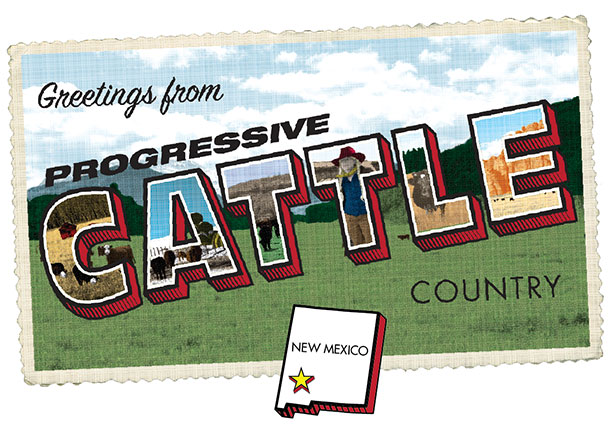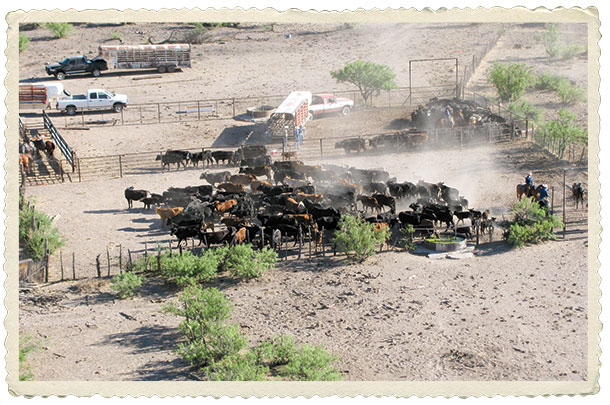Some areas of the country are more difficult than others in which to raise cattle. Southwestern New Mexico is one of these regions, although for a couple of reasons that may be unexpected.To begin with, this area of the country has very limited resources in terms of water and feed. The stocking rate for cattle is approximately five to six cows per section, or 640 acres. Water is scarce, and a lot of the area utilizes windmills, according to Dr. John Wenzel, extension veterinarian for New Mexico State University.
“The most common grasses we have are black gramma, tobosa grass and alkali sacaton,” says Lawrence Hurt of Hurt Cattle Co. in Hatchita, New Mexico. “To survive out here, you must stock conservatively and feed as needed. Moisture is the biggest challenge.”

However, the climate is fairly mild, and that is a big advantage, especially since there is little rainfall. “We can produce a calf with very little rain. We rarely get more than 10 inches of rain. For the last 15 years or so, we have only received 5 to 7 inches of rain a year,” he explains.
Generally, for cattle to survive in this climate, “they have to have a little bit of ear,” or Brahman influence. The majority of cows are crossbreds and are crossed with purebred-type bulls. The cows are usually a combination of Red Angus, Black Angus, Charolais, Brangus and Beefmaster, according to Wenzel.
“If you get a set of cows that work, you can raise some pretty good ones. We have large pasture load stocking-type ranches, and it’s a lifestyle these ranchers are accustomed to. These guys that survive are pretty good at it. The cattle are uniquely fit for that area, and the cattle perform pretty well,” explains Wenzel.
This area of the country is best fit for raising livestock, since the land is not suitable for raising crops. “It is the only way to harvest these lands. It is not good enough in most areas for any type of a crop production, and cattle grazing uses that reusable resource to turn into food,” states Caren Cowan, executive director of the New Mexico Cattle Growers Association.
The majority of these ranches are several thousand acres, and that is predominantly federal or state land. “To be able to get a grazing lease, you have to have base property, with either deeded land or water in New Mexico,” she says.
Ranchers utilize their own land, in addition to leases on public land, to graze their cattle. “This year has been an issue for ranchers because their rates are based off the high cattle prices from last year, and since that time, the market has dropped out.

We have hope that early next year it will come back down due to the drop in the cattle market,” states Cowan.
Life on the border
Even with these tough conditions, that is not the biggest threat to ranchers in this area: It is border security. Ranchers in this area fear for their lives on a daily basis because of the people who are coming across the U.S./Mexico border.
Most ranchers will agree it is not immigrants coming to the U.S. looking for work that are the problem, but those who are trafficking drugs, as well as criminals. These people have killed ranchers, kidnapped people doing business and stolen personal property.
“We deal with drug smugglers on a daily basis. Every day, we have to go look and find what they have been into and torn up. The biggest concern we have is getting yourself killed and being in the wrong place at the wrong time,” explains Hurt.
In the past, ranchers would offer food and water to immigrants passing through that needed it, but those days are long gone. “We have seen these people around and try to help them, but now we are very, very cautious.
Our biggest concern is for our personal safety. We have to carry a weapon all the time to protect ourselves,” he states.
Finding backpacks with drugs in them is also not unusual. “On a regular basis we will encounter drugs, and we call the authorities for that,” Hurt says.
In general, ranchers try to keep a low profile and let the authorities handle these situations. “If they [ranchers] do anything, it puts a target on their back. The federal agencies are not very concerned about the ranchers in that area.
The ranchers just try to hang together. There is a lot of the border that is barbed wire fence, but it’s not a barrier,” says Wenzel.
The movement of people across pastures where cattle are is a problem as well. “With immigration or drug trafficking, the people are the direct disruption. They tend to keep cattle off of water, and that is a big problem,” Wenzel states.
He continues, “A lot of the immigrant traffic will camp on water. In southwest New Mexico, there are very limited sources of water for cattle to drink from. We have had cattle die because they could not get to water.”
This disruption causes problems in pregnancy rates and weight gain, both of which affect a rancher’s bottom lines.
People traveling across the areas will also start fires. “In Arizona, some of the catastrophic forest fires they have had have been from people traveling through. They will start a fire so someone will come find them,” says Cowan.
The impact on cattle
Drug traffickers tend to have little regard for personal property and will cut fences and leave gates open when they come across a rancher’s property. A side effect of this issue is disease introduction. One of the biggest concerns is with trichomoniasis and foot-and-mouth disease (FMD). Trich is present in the U.S. and in Mexico, and FMD is present in South America.
A recent study conducted by the Universidad Autónoma de Chihuahua (UACH) and Thermo Fisher Scientific showed that nearly 25 percent of the bulls in the State of Chihuahua were infected with trich. When fences are cut in ranches on the border, cattle can commingle, which could potentially expose cattle to this disease.
FMD is the biggest risk to ranchers, according to Wenzel. Although Mexico is currently listed as FMD-free, as is the U.S., this disease is highly contagious and can be brought in through manure on shoes.
“The concern is that a lot of them may be from South America, where foot and mouth is. It is a risk because they have a backpack and prepared meat and foods, so that is always a concern,” states Wenzel.
One additional challenge ranchers have in this area is the reintroduction of the Mexican gray wolf and other endangered species listings.
The Mexican Wolf Reintroduction Project covers the Blue Range Wolf Recovery Area (BRWRA) and was started in March of 1998. Currently, there are approximately 97 Mexican gray wolves in the wild, covering the states of Arizona and New Mexico, according to the Fish and Wildlife Service. The wolves are on the endangered species list.
“The program is a failure. Most of them have been fed at some point in their lives and are not afraid of humans, and they prey on our livestock,” says Cowan.
She continues, “There are people losing 10 to 15 head of cattle in a month, and the government does not pay for that. Before the cattle market dropped last year, $50,000 worth of cattle were killed on one ranch, and the government program only offered to pay the rancher $5,000. Some people have given up and moved out.”
Other listings of species on the endangered species list have led to riparian areas being fenced off. “This causes a reduction in our herd because of the decrease in access to water. Ranchers usually have to pay for the fence, and maintain it, and there’s a cost involved with that as well,” states Cowan.
As recently as August of 2016, some New Mexico National Park land is being closed down to protect the New Mexico meadow jumping mouse. Campers are taking down electric fence in the area which was originally put up to keep cattle out of riparian areas.
All of these challenges can make ranching in southwest New Mexico tough. However, even with the concerns ranchers have, many choose to stay.
“The country is rugged, but the grass is strong, and we have good people,” says Cowan. “We have a family heritage and a cultural heritage that people believe in.” ![]()
PHOTO 1: This area receives less than 10 inches of rain a year, creating dry, dusty conditions.
PHOTO 2: Cattle are sorted at Hurt Cattle Co. Ranch in the bootheel of New Mexico, along the border with Mexico. Photos were taken by Hank Hayes, and provided by Dr. John Wenzel.

-
Robyn Scherer-Carlson
- Freelance Writer
- Kiowa, Colorado
- Email Robyn Scherer-Carlson








